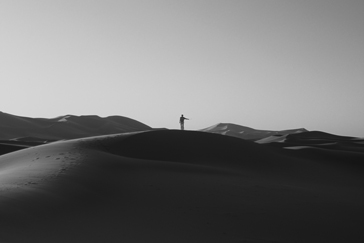
Born in 1981 in Glasgow (GB). Lives and works in London (GB)

2010
Gelatin-silver print
84 x 100 cm
Year of Purchase: 2013
“To see a World in a Grain of Sand…” – William Blake 1
Each of the projects conceived by the Scottish artist Katie Paterson opens onto and lends an ear to what is most imperceptible, to disappearance, and diffracts time, space, and distance. They also open onto and tune into what is infinitely large and infinitely small, what echoes through its immensity and contains elements of the invisible, inaudible, illegible, and impossible for human perception: what the physical eye and ear are unable to grasp through mere mediation of appearances. Trained at the Edinburgh College of Art and at the Slade School of Fine Art in London, Paterson collaborated on a series of conceptual projects (with astrophysicists, astronomers, writers…) which took the infinity of cosmic and geological phenomena, the infinity of possible temporalities—from the human timeline to the cosmic time-space, from paleontological and historical to ecological temporalities—as the subject of “reflection,” “experience,” and as the “material” and the “acceleration point” of the imagination. Katie Paterson belongs to the generation of artists born in the early 1980s who are sensitive to environmental issues, and is part of the conceptual art and environmental art movements of the 1960s and 70s. Employing the modalities of mail art (The Dying Star Letters , 2010), sound art (Vätnjökull (the sound of) , 2007; Earth-Moon-Earth (Moonlight Sonata Reflected from the Surface of the Moon) , 2007), and “cartographic art,” Paterson transmits and reveals the “poetic economy” wherein art, science, and technology communicate and enrich one another.
At the time of the conception of Inside this Desert Lies the Tiniest Grain of Sand (2010), Paterson was still exploring distance, disappearance, temporal scale, bringing time and infinity to a provisory, poetic visibility or to an instant t., which is the instant of the work. Thus in Inside this Desert… the artist commissioned nanotechnology specialists to cut a grain of sand she had brought from the Sahara Desert to the smallest size possible to date (that is, 0.00005 mm). Peterson then buried this tiny piece of a grain of sand in the very landscape of shifting dunes; a black-and-white photograph is not so much a testimony to this performative gesture as a poetic measure of the body of the artist wedded to the title of her work: “Inside this desert lies the tiniest grain of sand.”
Marjorie Micucci
1 «“To see a world in a grain of sand / And a heaven in a wild flower, / Hold infinity in the palm of your hand, /And eternity in an hour.” — William Blake, Auguries of Innocence and Other Lyric Poems, CreateSpace Independent Publishing Platform, 2014.